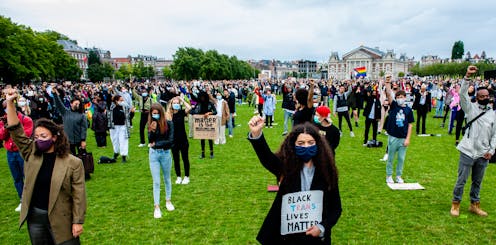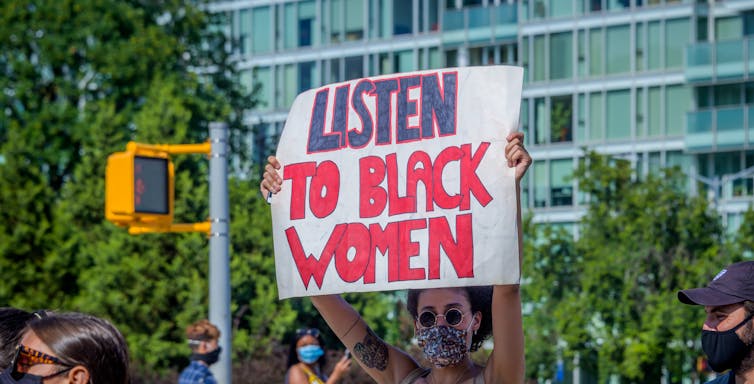5 takeaways from MacKenzie Scott's $1.7 billion in support for social justice causes
- Written by Elizabeth J. Dale, Assistant Professor of Nonprofit Leadership, Seattle University
 Jeff Bezos's ex-wife is funding efforts to dismantle racism and fight homophobia.Romy Arroyo Fernandez/NurPhoto via Getty Images
Jeff Bezos's ex-wife is funding efforts to dismantle racism and fight homophobia.Romy Arroyo Fernandez/NurPhoto via Getty ImagesThe author and philanthropist MacKenzie Scott has announced that she’s disbursed nearly US$1.7 billion to 116 organizations, since first publicly discussing her giving intentions in May of 2019. Most of the organizations aim to advance racial, gender and economic equity, are dedicated to dealing with climate change, support democracy or are tied to other generally progressive causes.
In the public blog post she wrote to break the news, Scott encouraged donors of all financial means to join her. Previously known as MacKenzie Bezos, before her divorce from Amazon founder and CEO Jeff Bezos, the philanthropist also announced that from now on she’ll be using her middle name as her new last name. She left it up to the causes she’s funding to reveal precise totals for each gift. Howard University and Tuskegee University, two of several historically Black colleges and universities receiving her donations, said these were the biggest gifts they’d ever gotten from an individual donor.
As a scholar of philanthropy, I believe that Scott is modeling five best practices for social change giving.
1. Don’t attach strings
All of Scott’s 116 gifts – many in the millions or tens of millions, like the $30 million she gave Hampton University and the $40 million to the Local Initiatives Support Corporation, which advocates for and builds affordable housing, were made without restrictions. Rather than specify a purpose, as many large donors do, Scott made it clear that she trusts the organizations’ leaders by providing absolute flexibility in terms of how to use her money to pursue their missions. This hands-off approach gives nonprofits an unusual amount of freedom to innovate while equipping them to weather crises like the coronavirus pandemic.
2. Champion representation
According to Scott, 91% of the racial equity organizations she funded, such as the Movement for Black Lives and LatinoJustice, are run by leaders of color. All of the LGBTQ+ equity organizations, such as the National Center for Lesbian Rights and the Transgender Law Center, that she’s backing are led by LGBTQ+ leaders. And 83% of the gender equity organizations, such as the Indian nonprofit Educate Girls, are run by women. She says this approach brings “lived experience to solutions for imbalanced social systems.” Backing groups led by people directly affected by an issue is a common tenet of social justice giving at a time when organizations led by people of color receive less funding than white-led groups.
In addition, some of her other gifts to grassroots organizations like Southerners on New Ground, an LGBTQ community-organizing nonprofit, direct support to a region of the U.S. that is often overlooked by donors and foundations.
 To support these causes, Scott sought out nonprofits led by people from the communities involved.Erik McGregor/LightRocket via Getty Images
To support these causes, Scott sought out nonprofits led by people from the communities involved.Erik McGregor/LightRocket via Getty Images3. Act first, talk later
Rather than making lengthy announcements about her plans, Scott chose to distribute this money rapidly and directly. Unlike her philanthropic peers like Priscilla Chan and Mark Zuckerberg, or Bill and Melinda Gates, Scott’s first round of giving wasn’t channeled through a large-scale foundation or other entity, like the Chan Zuckerberg Initiative, bearing her own name or that of another billionaire. And when she made her public announcement, the gifts were already made.
4. Don’t obsess about scale
Many of the organizations receiving these gifts are relatively small in scale and lack widespread name recognition. The multiracial justice group Forward Together and the Campaign for Female Education, a global aid group often called CAMFED, for example, until recently operated on annual budgets of $5.5 million or less, while the Millennial Action Project had an even smaller budget.
[Get the best of The Conversation, every weekend.Sign up for our weekly newsletter.]
5. Leverage more than money
Philanthropy that’s intended to bring about social change inherently expresses the donor’s values, Scott acknowledged in her announcement. She also recognized her immense privilege, highlighting the need to address societal structures that sustain inequality. And like the many women donors I’ve interviewed and studied, she is using her position as the world’s second-wealthiest woman to amplify the voices of the leaders and groups she supported. Her goal is to encourage others to give, join or volunteer to support those same causes.
As Scott noted, the issues her philanthropy addresses are complex and will require sustained and broad-based efforts to solve.
Elizabeth J. Dale has received funding from the Ford Foundation, the Bill & Melinda Gates Foundation via Indiana University and The Giving USA Foundation for her research on philanthropy. The views expressed in this essay are strictly my own and do not reflect policy stances of Seattle University.
Authors: Elizabeth J. Dale, Assistant Professor of Nonprofit Leadership, Seattle University

